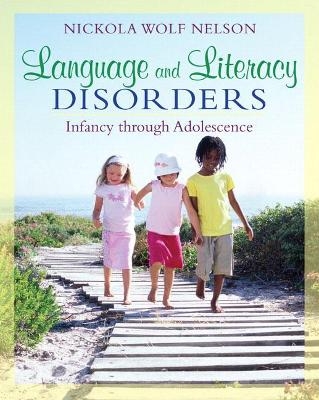
Language and Literacy Disorders
Pearson (Verlag)
978-0-205-50178-6 (ISBN)
Featuring content and questions that encourage deeper thinking about the nature of disordered and normal development, this text makes assessment and intervention practices relevant to contexts of home, classroom, and peer interactions. In particular, readers will learn to draw on multiple sources of input to develop an assessment picture for a child at any age and stage of development as a person with unique strengths and needs, coming from a particular cultural-linguistic background, and with concerns that may be attributed to a particular known or unknown but suspected set of etiological factors. Additionally, readers will learn to plan interventions that target developmentally appropriate outcomes in spoken and written language and to apply techniques that are informed by varied theoretical perspectives and a growing evidence base.
This text is organized into three sections that are designed to promote understanding of: (1) basic concepts, taxonomies, policies, and procedures that can inform other decisions; (2) implications of common etiologies (e.g., primary language impairment/learning disability, hearing impairment, autism spectrum disorders, mental retardation/cognitive impairment; acquired neurological impairment) for modifying assessment and intervention practices; and (3) appropriate assessment and intervention procedures across developmental language and literacy ages, stages, and targets. Instructors can guide students through the sections and chapters, review and practice material, and extended exercises, so students can gain confidence they will know what to do when facing diverse populations of real children in a variety of settings.
Although the book is written primarily for students in speech-language pathology, it draws on the author’s experience working in schools and classrooms with general and special education teachers and other interdisciplinary team members and can be used with (or by) members of other disciplines and by practitioners as well as students. The ultimate beneficiaries of this book should be children and adolescents who grow up with improved abilities to communicate, read, write, listen, and speak because they received services from professionals who knew what they were doing and why.
Nickola Wolf Nelson, Ph.D., CCC-SLP conducts research and has authored numerous research articles, books, and chapters on contextualized, interdisciplinary approaches to language and literacy assessment and intervention, including two prior editions of Childhood Language Disorders in Context: Infancy through Adolescence (Allyn & Bacon, 1994, 1998). Nelson is co-author of The Writing Lab Approach to Language Instruction and Intervention (Paul H. Brookes, 2004) and the forthcoming Test of Integrated Language and Literacy Skills.
TABLE OF CONTENTS
Frontmatter Dedication page
Preface
Table of contents
PART I. FRAMEWORKS FOR CLINICAL PRACTICE
Chapter 1. A Framework for Guiding Evidence Based Practice
Importance of asking good questions
Contextualized assessment and intervention
World Health Organization definitions
Chapter 2. Speech, Language/Literacy, and Communication
Speech, language (including literacy), and communication
Five language parameters
Content, form, and use
Language levels and modalities
Cultural-linguistic variation
Chapter 3. Language/Literacy and Related Systems
Theoretical accounts
System theory
Systems supporting language development
PART II. POLICIES, PRACTICES, AND POPULATIONS
Chapter 4. Policies and Practices
Policies
Clinical practices
Categorization, diagnosis, and causation
Testing and exclusionary factors in diagnosis
Prevalence, prevention, and prognosis
Chapter 5. Primary Disorders of Speech, Language, and Literacy
Speech-sound disorders
Language impairment
Learning disability
Spoken and written language associations and dissociations
Chapter 6. Special Populations with Motor and Sensory Disorders
Motor system impairment
Auditory system impairment
Visual system impairment
Other sensory problems
Chapter 7. Special Populations with Cognitive-Communicative Disorders
Developmental disability
Intellectual disability
Autism spectrum disorders
Acquired brain injury (including traumatic brain injury)
Child abuse and neglect
Interactive disorders of attention, emotion, and behavior
PART III. ASSESSMENT AND INTERVENTION
Chapter 8. Infant/Toddler Policies and Practices
Policies and practices for infants and toddlers
Comprehensive assessment for infants and toddlers
Chapter 9. Infant/Toddler Intervention
Prelinguistic organization to intentional communication
Joint action routines and early play
First words to two-word utterances
Emergent narratives and literacy
Chapter 10. Preschool Policies and Practices
Policies and practices in the preschool years
Comprehensive assessment in the preschool years
Chapter 11. Preschool Intervention
Sounds, words, and vocabulary concepts
Sentence- and discourse level development
Social interaction and play
Emergent and early literacy
Chapter 12. School-age Policies and Practices
Policies and practices in the school-age years
Comprehensive assessment in the school-age years
Chapter 13. School-age Intervention
Intervention scaffolding in the school-age years
Discourse-level knowledge and skills
Sentence-level knowledge and skills
Word-level knowledge and skills
Chapter 14. Interventions for Special Populations
Comprehensive planning for comprehensive needs
Preverbal to intentional communication
Echolalia, challenging behaviors, and non-symbolic communication
Intervention for children and adolescents with severe speech-production disorders
AAC for children and adolescents with complex communication needs
Intervention for sensory loss and central processing disorders
Intervention for cognitive-communicative disorders
Intervention for autism spectrum disorders
Backmatter: Appendices for Part III.
References
Author Index (to be completed by Allyn & Bacon)
Subject Index (to be completed by Allyn & Bacon)
On line supports: Glossary
Review and practice questions and key
Observation tables
| Erscheint lt. Verlag | 7.8.2009 |
|---|---|
| Sprache | englisch |
| Maße | 100 x 100 mm |
| Gewicht | 100 g |
| Themenwelt | Medizin / Pharmazie ► Gesundheitsfachberufe ► Logopädie |
| Sozialwissenschaften ► Pädagogik ► Sonder-, Heil- und Förderpädagogik | |
| ISBN-10 | 0-205-50178-8 / 0205501788 |
| ISBN-13 | 978-0-205-50178-6 / 9780205501786 |
| Zustand | Neuware |
| Haben Sie eine Frage zum Produkt? |
aus dem Bereich


